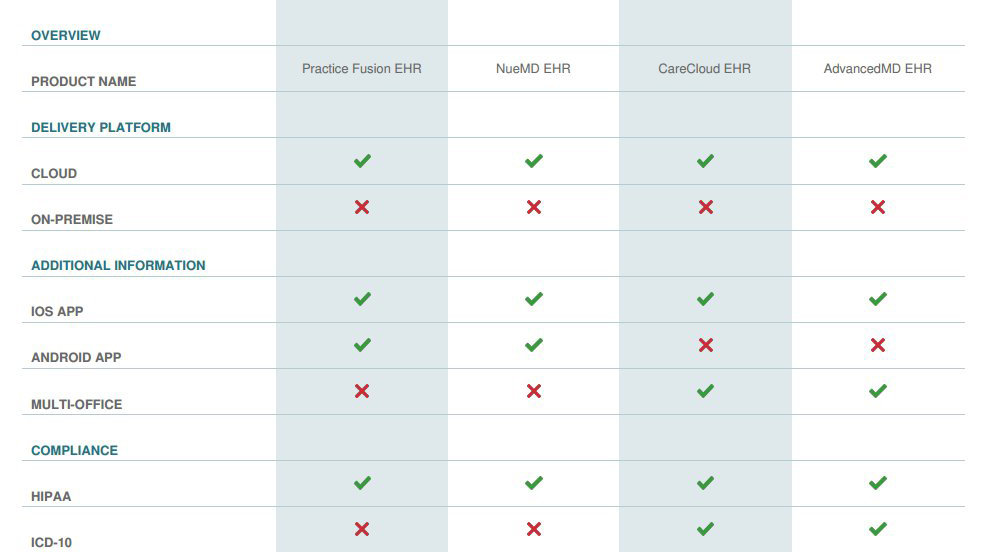Podiatry EHR buyers' guide
Podiatry practices, like other specialty practices, face several important questions when it comes to selecting EHR. Foremost among these concerns involves the type of EHR features podiatrists require. The types of features a podiatry practice will need depends on consideration of a combination of factors among which include clinical and administrative needs.
Podiatry practices, like other ambulatory practices, will require a core set of requirements including interoperability as podiatry patients are often receiving care in other settings. An EHR should also allow the sharing of clinical information with other physicians, outside laboratories, pharmacies, x-ray, and imaging centers.
When selecting an EHR product specifically designed for podiatry practices must be mindful of their unique requirements regarding their technology needs. These needs are guided by the unique aspects of podiatry practices, such as the specific types of tests and examinations podiatrists conduct, the unique clinical data podiatrists collect and specific needs guided by their patient population which require consideration of comorbid conditions and the need to effectively coordinate with other healthcare providers.
Despite clearly specific requirements, podiatrists also should keep in mind that with their specialized needs, at the core they will share some of the same requirements as general practices. As such, selection teams will need to keep in mind, and balance core and specialty requirements.
How to select the best podiatry EHR
Before beginning the process of considering the best podiatry EHR software should follow best practices for requirements gathering. A successful requirement gathering process involves the following:
- Clear, objective, and measurable goals.
- Understanding how an EHR will contribute to your practice’s goals.
- Subsequent knowledge of which EHR features best compliment achieving your practice’s goals.
Upon creating a representative and actionable list of features, practices will then begin to consider the core and podiatry specific features they will require.
Core features podiatry practices should consider
The core features a podiatry practice will require should be based on a consideration of the features and functionality that will ensure that a podiatry practice can fulfill its basic clinical and administrative mission.
The Institute of Medicine (IOM) has identified what it considers key capabilities of an electronic health record system, or a set of eight core functions of EHR systems should be capable of performing. These core functions are viewed as essential to the basic operation of a healthcare practice. These core features are:
- Data storage and management: Storing clinical information and data in an electronic format that can be retrieved and viewed efficiently.
- Result management: the ability to manage test results.
- Order management: electronic processing of orders and prescriptions.
- Decision support: warn providers of possible risk and provide information to aid in clinical decision-making.
- Electronic communication and connectivity: communicate and connect with other providers across multiple care settings.
- Patient support: provide patients with information and allow patients to communicate with their provider.
- Administrative processes and reporting: practice management functionality such as billing and scheduling, among others.
- Reporting and population health: produce and share reports on clinical data concerning patient population health.
Podiatry EHR features
In addition to the core features outlined above, podiatry practices will also require a set of features that are specific to podiatry. The types of features your organization considers to be a prioritized requirement will depend on your practice’s requirements, budgetary concerns, and overall technology strategy.
Podiatry billing software
Podiatry EHRs often contain an integrated practice management system that includes billing software that allows billing functions to be automated. Given the importance of keeping revenue streams flowing, billing software that can accurately code for podiatry related services, manage billing and reimbursement with CMS and private insurance providers and manage outstanding bills is vital.
Podiatry note templates
The workflows in a podiatry practice can be made more efficient with podiatry-specific note templates that account for diverse range of treatments, conditions and other clinical information. These types of clinical data include pre and post-operative care, wound care, diabetic care, sports medicine, and pediatric podiatry among others.
MIPS scoring, tracking and analysis.
Podiatry practices should consider selecting an EHR that provides the ability to collect quality of care and performance data for the Centers for Medicare and Medicaid (CMS) Merit Based Incentive Payment System (MIPS). A podiatry EHR should possess the ability to track and report on the relevant quality measures under the MIPS program and allow for an organization to analyze these data to craft internal policies that can improve on these measures.
Cloud-based deployment and mobile capabilities
Cloud-based EHRs offer a wide range of features attractive to ambulatory practices such as podiatry practices which allow for a great deal of scalability and data portability by easily integrating with mobile solutions that provide for on-demand data. As such, podiatry practices should consider a secure cloud-based EHR that allows for customization and scalability while also allowing staff to move freely with mobile devices while providing care.
Speech recognition
Clinical workflows in a podiatry practice can be improved by cutting down the time and effort needed to input clinical information into the EHR. Speech recognition technology and hands-free data can provide staff with the ability to quickly and easily enter data into the EHR without drops in productivity. In addition to more efficient data entry, clinicians with speech recognition technology at their disposal can better engage with patients given the need to type at a workstation would be eliminated.
Care coordination
A vast majority of the patients receiving care from a podiatry practice will likely be under the care of other providers. Further, in some cases these patients may suffer from comorbid conditions directly related to their visit to their podiatrist. In these cases, a podiatry EHR should be able to seamlessly exchange clinical information across care settings.
Selecting a podiatry specific EHR can present some challenges, however these challenges are no worse than those faced by other practices. With a properly planned and executed requirements gathering process podiatry practices can navigate this process successfully.















